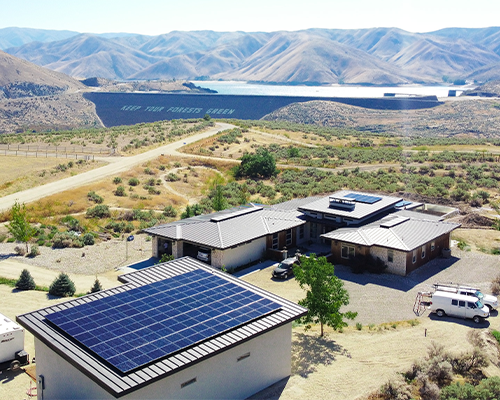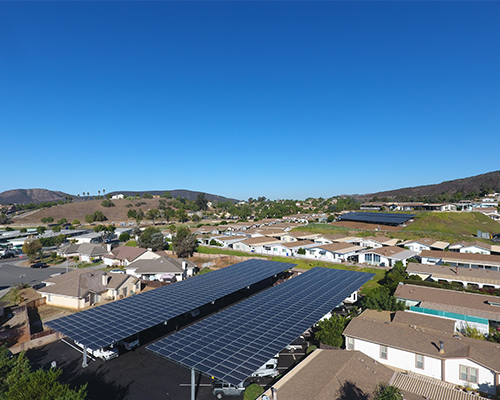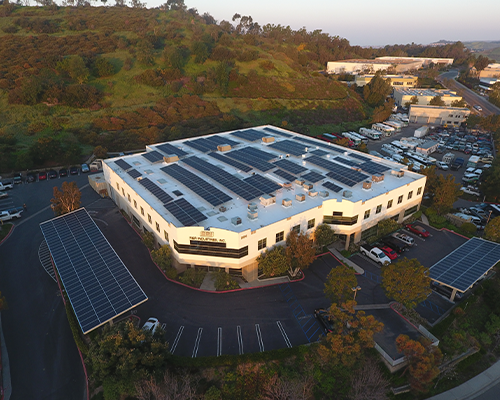eagle® encore
for home
SOLAR & STORAGE 101
WHAT TO EXPECT
Home and business owners add solar and energy storage to save on electricity bills, cut operating costs, and lock in energy rates. Start by learning some basics that can help you decide whether solar and energy storage are right for you
Solar panels generate DC power when exposed to sunlight. They are mounted on your roof with racks and paired with an inverter or several microinverters, which convert the DC power into AC power that your home or business can use. Energy storage systems use batteries, which store energy generated by the grid or by solar panels. These batteries can be installed in your garage or on the side of your house and are paired with an inverter which converts the power to AC power that your home or business can use.

Solar + Storage system overview
Features roof mounted panels, inverter (or several micro inverters), a power meter, and batteries.

Solar works all over the country for homeowners and small businesses, but it’s especially popular in areas with great sunshine or good local incentives. States with net metering allow your meter to spin backward as your solar panels generate more electricity than you use. You only pay the utility what’s left on the meter. Learn more about net metering. Energy storage systems can backup critical loads in your home or business. When the power goes out, the energy storage system kicks in to provide power to critical things like refrigerators or air conditioning. In some areas, there are high demand charges from the utility, or rates that peak at certain periods (time-of-use rates). The energy storage system can store energy generated by solar in the middle of the day when utility rates are low, then discharge that energy when rates are high, so you are not using the utility’s expensive power at that time.
Shade will definitely impact solar panel performance, though our new half-cell technology mitigates the impact of shade and still allows the solar panels to generate a lot of power. Energy storage relies on solar or the grid to power the batteries, so it too is affected if the solar system is underperforming. Physically however, energy storage systems are installed in a garage or a shaded area outside away from direct sun to protect the longevity of the batteries.
New solar systems come with rapid shutdown devices which ensure that the system turns off in emergencies such as fires. As the only energy generating device that requires no movement, solar systems are very safe and require little maintenance. Energy storage systems mostly use lithium ion batteries. These batteries come in several chemistries, including NMC and LFP. NMC is often seen in electric vehicles due to the compact nature of the batteries but have higher risk of thermal runaway. We use LFP, which is slightly larger but widely seen as a safer option. In addition, we have robust software embedded in the system which monitors and protects the battery’s state of charge and health.
The solar panels come with a standard 25-year power warranty and retain a high percentage of power at the end of the warranty. Recent data suggests these panels will function well beyond those 25 years. The panels are very durable and are effective at withstanding heat, hail, ice, snow, wind, and salt mist. We also have a strategic relationship with DuPont™ to ensure our panels are protected using extra-durable Tedlar® film. This film is used in the International Space Station and commercial jetliners, so it is very tough. Batteries don’t last quite as long, but we do offer a 10-year warranty, which covers the batteries and all other complementary components in the system. Many manufacturers cover only parts of the energy storage system, whereas we are solely responsible for everything.
The systems are not inexpensive. They can run tens of thousands of dollars. However, you will save a lot and payback periods can be as few as 3-4 years depending on where you live. How much you will save depends on the size of your systems, your current electricity prices, and local incentives. For energy storage, many areas prone to natural disasters have exceptionally high incentives which pay for a high percentage of the system. In many cases, due to the federal investment tax credit, which is currently 26% of the value of the solar and storage systems, you may save a lot on your taxes the following year. The value of the backup power from energy storage is hard to measure, but during power outages, keeping your refrigerator cold may be worth everything. Don’t wait too long, because the tax credit steps down to 22% in 2023 and will zero out in 2024. Our installers will outline these savings during the quotation process.
WHY JINKOSOLAR IS THE BEST CHOICE
If you still have questions
financing
There are many ways to go solar. The easiest is a cash purchase, which offers the fastest path to free electricity.
However, many financing options require no out-of-pocket expense.
LOAN
Many competitive loan offerings with low interest rates and up to 20 years.
LEASE
Power Purchase Agreement: No money down, no out-of-pocket expense. Immediate savings on utility bill.
INTELLIGENT LIVING
Today’s buyers demand intelligent, intuitive homes. People are seeking a more efficient lifestyle. That might mean living small or living smart. We have partnered with Green Builder Media and Dvele Homes to demonstrate solar and storage powered next generation living.

TRANSCEND
DESIGNED FOR RESILIENT, LOW-IMPACT, HIGH QUALITY LIVING
Transcend communities will feature Dvele homes that are net-zero, all-electric, healthy, connected, resilient, solar-powered and cost-effective, as well as amenities that are desirable for today’s home buyers, such as community gardens, walking trails, co-working spaces, wellness centers, EV-charging stations and shared transportation options.
Showcasing the most cutting-edge technologies available on the market today, these net-zero carbon communities will be mini-microgrids–powered by renewable energy with battery storage, producing as much energy as they consume and using smart technologies to optimize energy management.
Learn how to get involved in a Transcend community near you!
residential and commercial









CONTACT SALES
Submit this form and we’ll put you in touch with a JinkoSolar representative or distributor who can provide the information and assistance you need.
